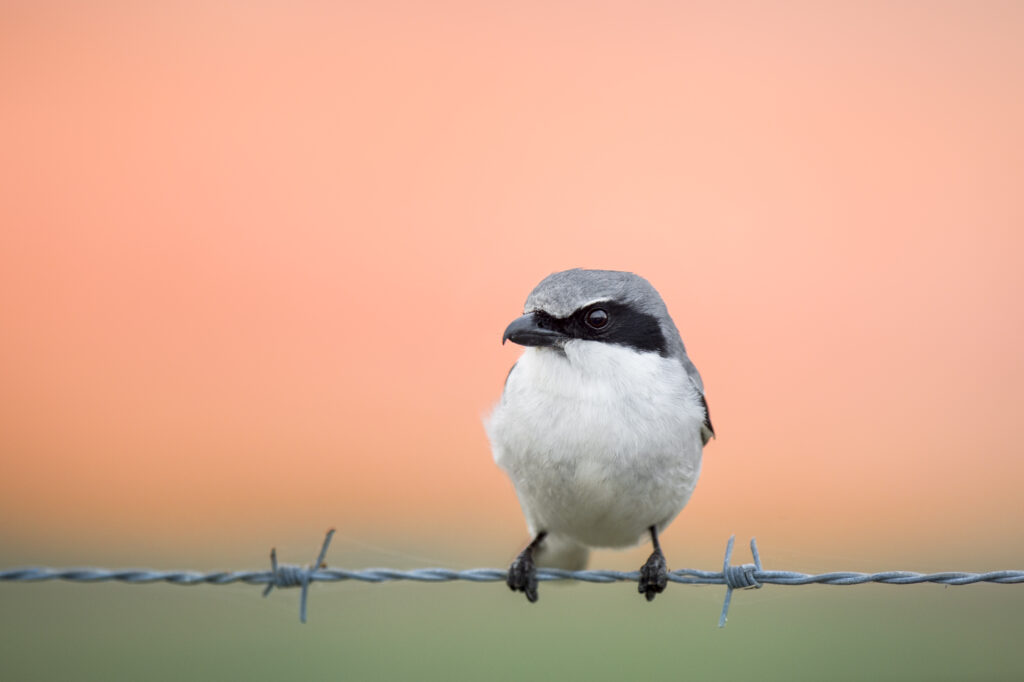With as gruesome a nickname as the “butcherbird,” you can imagine that the Loggerhead Shrike has a few skeletons in its closet. These songbirds may be small and harmless-looking, but make no mistake. The Loggerhead Shrike is a predator, and an infamous one at that. For such a charming little bird, its brutality is the stuff of legend.
The Loggerhead Shrike (Lanius ludovicianus) is a small black and white songbird with a relatively large head — the source of its name. These birds are endemic to North America and found throughout much of the contiguous United States. Despite its bloody reputation, the Loggerhead Shrike does possess a certain allure. It is a fierce bird in a small package that reminds us not to make hasty judgements based on appearance. Looks, after all, can be deceiving.
Related Article: Species Spotlight: The Mississippi Kite
Fun Facts About the Loggerhead Shrike
The Loggerhead Shrike is a fascinating bird whose diminutive size belies a ferocious fighting spirit. Let’s dive into some fun, and a few perhaps not-so-fun, Loggerhead Shrike facts!
David and Goliath: The Loggerhead Shrike is known for its incredible ability to take down prey as large as itself and sometimes even larger. Despite being songbirds themselves, Loggerhead Shrikes often hunt small birds, reptiles, and mammals on top of their more typical prey of insects. When they capture larger prey, they use their feet to help carry their prize.
Bend and snap: The hooked end of the Loggerhead Shrike’s bill is the only easy visual clue that this bird is a killer. This sharp tip features built in projections called “tomial teeth” that Loggerhead Shrikes may use to pierce the spinal cords of large prey, immobilizing or killing them. Despite lacking the strong talons that hawks use to hunt, Loggerhead Shrikes hunt in a similar fashion, swooping down on prey from high perches. Their comparatively large heads and thick necks allow them to twist their prey at the nape of the neck, allowing them to easily kill animals that ought to be too large for such a small bird to handle.
A grim pantry: The Loggerhead Shrike is perhaps most famous for its habit of “caching” its kills. Caching food is a common bird behavior, but Loggerhead Shrikes take this to a new level, using sharp thorns and barbed wire protrusions to impale their prey. For poisonous insects like the monarch butterfly, Loggerhead Shrikes use caching as a means of ensuring their food is safe for consumption. In the cases of some prey, though, impalement is done while the animal is alive. For larger prey, they may impale the animal to aid in killing it or to give the shrike leverage for tearing off flesh. In any case, haunting images of bugs, small mammals, and birds impaled on thorns or sharp branches are one of the most salient associations connected with this bird.
No honor among thieves: If impalement is not enough of a crime, Loggerhead Shrikes are also known to be thieves, engaging in a behavior known as “kleptoparasitism.” It’s a long word for a very simple concept. Some Loggerhead Shrikes will watch other songbirds and steal their food when an opportunity presents itself. This has been observed in Loggerhead Shrikes on multiple occasions, but it is not a common behavior.
Practice makes perfect: How does a young bird learn to impale its prey? Practice of course! Young Loggerhead Shrikes are sometimes observed performing exaggerated “play” versions of adult behaviors. Despite this, impalement seems to be a somewhat innate urge for them. In a population of captive-raised birds, young shrikes developed impaling behavior with or without having observed adults doing so. The only conditions under which they did not develop this behavior was when they were reared without encountering sharp objects to impale prey on for the first 70 days of life. After roughly 70 days, if they had never interacted with sharp branches or thorns then they would never display this behavior.
The Future of the Loggerhead Shrike
The Loggerhead Shrike is considered by the IUCN Red List of Threatened Species to be “Near Threatened” and declining. Sharp population decline has been a serious issue for these birds in the northeastern parts of the United States, however their numbers are decreasing across a huge swathe of their habitat. It is thought that the widespread use of pesticides may be partially responsible for this decline, however no one single reason has been posited as the primary cause.
Popular Article: Our Neolithic Ancestors Hunted Songbirds According to New Archeological Findings

